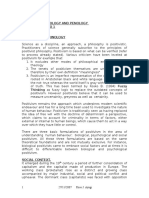0 ratings0% found this document useful (0 votes)
55 viewsTheories of Crime Causation: What Is Criminology?
This document provides an overview of the history and development of criminology. It discusses early theories from the Middle Ages through the 18th century Classical period. It then covers the rise of Positivism in the 19th century, including biological and psychological approaches. Next, it examines Cesare Lombroso's theory of the "criminal man" and the emergence of sociological criminology through the works of Quetelet, Durkheim, and the Chicago School. The document traces the evolution of criminology from superstition to a scientific, data-driven field of study.
Uploaded by
isaiah bungalsoCopyright
© © All Rights Reserved
Available Formats
Download as PDF, TXT or read online on Scribd
0 ratings0% found this document useful (0 votes)
55 viewsTheories of Crime Causation: What Is Criminology?
This document provides an overview of the history and development of criminology. It discusses early theories from the Middle Ages through the 18th century Classical period. It then covers the rise of Positivism in the 19th century, including biological and psychological approaches. Next, it examines Cesare Lombroso's theory of the "criminal man" and the emergence of sociological criminology through the works of Quetelet, Durkheim, and the Chicago School. The document traces the evolution of criminology from superstition to a scientific, data-driven field of study.
Uploaded by
isaiah bungalsoCopyright
© © All Rights Reserved
Available Formats
Download as PDF, TXT or read online on Scribd
You are on page 1/ 7
THEORIES OF CRIME CAUSATION
WHAT IS CRIMINOLOGY?
Criminology is the scientific approach to the study of
criminal behavior. In their classic definition,
criminologists Edwin Sutherland and Donald Cressey
state:
“Criminology is the body of knowledge regarding crime
as a social phenomenon. It includes within its scope
the processes of making the laws, of breaking laws, and
of reacting toward the breaking of laws. The objective
of criminology is the development of a body of general
and verified principles and of other types of knowledge
regarding this process of law, crime and treatment.”
A BRIEF HISTORY OF CRIMINOLOGY
During the middle ages, superstition and fear of
satanic possession dominated thinking. People who
violated social norms or religious practices were
believed to be witches or possessed by demons. (The
prescribed method for dealing with the possessed was
burning at the stake, a practice that survived into the
17th century. For example, between 1575 and 1590
NICHOLAS REMY, head of the Inquisition in the French
province of Lorraine, ordered 900 sorcerers and witches
burned to death; a contemporary, PETER BINSFIELD, the
bishop of the German city of Trier, ordered the deaths
of 6500 people. An estimated 100,000 people were
prosecuted throughout Europe for witchcraft during the
16th and 17th centuries.
CLASSICAL CRIMINOLOGY
By the mid-18th century, social philosophers had begun
to call for rethinking the prevailing concepts of law
and justice. They argued for a more rational approach
to punishment, stressing that the relationship between
crimes and their punishment should be balanced and
fair. This view was based on the prevailing philosophy
of the time called UTILITARIANISM, which emphasized
that behavior must be useful, purposeful, and
reasonable. Rather than cruel public executions
designed to frighten people into obedience or to punish
those the law failed to deter, reformers called for a
more moderate and just approach to penal sanctions.
The most famous of these was CESARE BECCARIA, whose
writings described both a motive for committing crime
and methods for its control. Beccaria believed that
people want to achieve pleasure and avoid pain. It
follows that to deter crime, one must administer pain
in an appropriate amount to counterbalance the pleasure
obtained from crime. The writings of Beccaria and his
followers form the core of what today is referred to as
CLASSICAL CRIMINOLOGY. As originally conceived in the
18th century, classical criminology theory had several
basic elements:
1. In every society, people have free will to choose
criminal or lawful solutions to meet their needs or
settle their problems.
2. Criminal solutions maybe more attractive than
lawful ones because they usually require less work
for a greater pay off.
3. People’s choice of criminal solutions may be
controlled by their fear of punishment.
4. The more severe, certain and swift the punishment,
the better able it is to control criminal behavior.
The classical perspective influenced judicial
th
philosophy during much of the late 18 and the 19th
centuries. Prisons began to be used as a form of
punishment, and sentences were geared proportionately
to the seriousness of the crime.
NINETEENTH-CENTURY POSITIVISM
During the late 19th century, a new movement began that
would challenge the dominance of Classical position.
POSITIVISM developed as the scientific method began to
take hold in Europe. This movement was inspired by new
discoveries in biology, astronomy, and chemistry. If
the scientific method could be applied to the study of
nature, why not use it to study human behavior?
AUGUSTE COMTE (1798-1857), considered the founder of
sociology, applied scientific methods to the study of
society. According to Comte, societies pass through
stages that can be grouped on the basis if how people
try to understand the world in which they live. People
in primitive societies consider inanimate objects as
having life (for example, the sun is a god); in later
social stages, people embrace a rational, scientific
view of the world. Comte called this final stage the
POSITIVE STAGE, and those who followed his writings
became known as positivists.
As we understand it today, the positivist tradition has
two main elements. The first is the belief that human
behavior is a function of external forces that are
beyond individual control. Some of these forces are
social (such as the effect of wealth and class) while
others are political and historical (such as war and
famine). Other forces are more personal and
psychological (such as an individual’s brain structure
and his or her biological make up or mental ability).
Each of these forces operates human behavior.
The second aspect of positivism is its embracing of the
scientific method to solve problems. Positivists rely
on the strict use of empirical methods to test
hypotheses. That is, they believe in the factual,
firsthand observation and measurement of conditions and
events.
POSITIVIST CRIMINOLOGY
If the scientific method could be used to explain all
behavior, then it is to be expected that by the mid-19th
century “scientific” methods were being applied to
understanding criminality. The earliest of these
scientific studies were biologically oriented.
Physiognomists, such as J.K. Lavater, studied the
facial features of criminals to determine whether the
shape of ears, nose, and eyes and the distance between
them were associated with antisocial behavior.
Phrenologists, such as Franz Joseph Gall and Johann
Kaspar Spurzheim studied the shape of the skull and
bumps on the head to determine whether these physical
attributes were linked to criminal behavior.
By the early 19th century, the abnormality in the human
mind was being linked to criminal behavior patterns.
PHILIPPE PINEL, one of the founders of French
psychiatry, claimed that some people behave abnormally
even without being mentally ill. He coined the praise
MANIE SANS DELIRE to denote what eventually was
referred to as a psychopathic personality. In 1812, an
American, Benjamin Rush, described patients with innate
preternatural moral depravity. Another early
criminological pioneer HENRY MAUDSLEY believed that
insanity and criminal behavior are strongly linked.
CESARE LOMBROSO AND THE CRIMINAL MAN
In Italy, CESARE LOMBROSO was studying the cadavers of
executed criminals in an effort to scientifically
determine whether law violators were physically
different from people of conventional values and
behavior. Lombroso known as the “Father of
Criminology”, was a physician who served much of his
career in the Italian army. That experience gave him
ample opportunity to study the physical characteristics
of soldiers convicted and executed for criminal
offenses. Later, he studied inmates at institutes for
the criminally insane at Pavia, Pesaro, and Reggio
Emilia.
Lombrosian theory can be outlined in a few simple
statements. First, Lombroso believed that serious
offenders (those who engage in repeated assault or
theft related activities) have inherited criminal
traits. These “born criminals” have inherited physical
problems that impel them into a life of crime. This
view helped spur interest in a criminal anthropology.
Second, he held that born criminals suffer from
atavistic anomalies (physically, they are throwbacks to
more primitive times when people were savages. Lombroso
compared criminals’ behavior to that of the mentally
ill and those suffering from certain forms of epilepsy.
He concluded that criminogenic traits can be acquired
through indirect heredity from a “ degenerate family
with frequent cases of insanity, deafness, syphilis,
epilepsy and alcoholism among members”. Direct
heredity- being related to a family of criminals—is the
second primary cause of crime.
THE DEVELOPMENT OF SOCIOLOGICAL CRIMINOLOGY
At the same time that biological views were dominating
criminology another group of positivists were
developing the field of sociology to scientifically
study the major social changes that were then taking
place in 19th century society.
Sociology seemed an ideal perspective from which to
study society. The foundations of sociological
criminology can be traced to the works of L.A. J
(Adolphe) Quetelet (1796-1874) and Emile Durkheim
(1858-1917)
L.A.J QUETELET – Quetelet was a Belgian mathematician
who began (along with a Frenchman, Andre-Michel Guerry)
what is known as the cartographic school of
criminology. Quetelet, was one of the first social
scientists to use objective mathematical techniques to
investigate the influence of social factors, such as
season, climate, sex and age, on the propensity to
commit crime. Quetelet’s most important finding was
that social forces were significantly correlated with
crime rates.
EMILE DURKHEIM – (David) Emile Durkheim (1858-1917) was
one of the founders of sociology and a significant
contributor to criminology. His definition of crime as
a normal and necessary social event has been more
influential on modern criminology than any other.
According to Durkheim’s vision of social positivism,
crime is part of human nature because it has existed in
every age, in both poverty and prosperity. Crime is
normal because it is virtually impossible to imagine a
society in which criminal behavior is totally absent.
THE CHICAGO SCHOOL AND BEYOND
The primacy of sociological positivism was secured by
research begun in the early 20th century by ROBERT EZRA
PARK (1864-1944). ERNEST W. BURGESS (1886-1966) LOUIS
WIRTH (1897-1952) and their colleagues in the Sociology
Department at the University of Chicago. Known as the
Chicago School, these sociologists pioneered research
on the social ecology of the city and inspired
generation of scholars to conclude that social forces
operating in urban areas create criminal interactions;
some neighborhoods become “natural areas” for crime.
The Chicago School sociologists and their
contemporaries focused on the functions of social
institutions and how their breakdown influences
behavior.
By mid-century, most criminologists had embraced either
the ecological or the socialization view of crime.
However, these were not the only views of how social
institutions influence human behavior. In Europe, the
writings of another social thinker, KARL MARX (1818-
1883) had pushed the understanding of social
interaction in another direction and sowed the seeds
for a new approach in criminology.
CONFLICT CRIMINOLOGY
Oppressive labor conditions prevalent during the rise
of industrial capitalism convinced Marx that the
character of every civilization is determined by its
mode of production – the way its people develop and
produce material goods (materialism). The most
important relationship in industrial culture is between
the owners of the means of production- the capitalist
bourgeoisie – and the people who do the actual labor –
the proletariat. The economic system controls all
facets of human life consequently, people’s lives
revolve around the means of production. The
exploitation of the working class, he believed would
eventually lead to class conflict and the end of the
capitalist system.
While Marx did not attempt to develop a theory of crime
and justice, his writings were applied to legal studies
by a few social thinkers, including Ralf Dahrendorf,
George Vold and Willem Bonger.
Though these writings laid the foundation for a Marxist
criminology, decades passed before Marxist theory had
an important impact on criminology. In the United
States during the 1960’s, social and political upheaval
was fueled by the Vietnam War, the development of an
antiestablishment counterculture movement, the civil
rights movement, and the women’s movement. Young
sociologist who became interested in applying Marxist
principles to the study of crime began to analyze the
social conditions in the United States that promoted
class conflict and crime. What emerged from this
intellectual ferment was a Marxist-based radical
criminology that indicted the economic system as
producing the conditions that support a high crime
rate. The radical tradition has played a significant
role in criminology ever since.
You might also like
- Legal Philosophy - Positivist Theory in Criminal LawNo ratings yetLegal Philosophy - Positivist Theory in Criminal Law14 pages
- Introduction To Criminology: Prof. Kristine C. Dolloso, Msca, CSP, RcrimNo ratings yetIntroduction To Criminology: Prof. Kristine C. Dolloso, Msca, CSP, Rcrim31 pages
- Theories-of-Crime-Causation-Alexis-R.-AlcantaraNo ratings yetTheories-of-Crime-Causation-Alexis-R.-Alcantara38 pages
- Review-Notes-in-Introduction-to-Criminology-1No ratings yetReview-Notes-in-Introduction-to-Criminology-115 pages
- Legal Philosophy - Positivist Theory in Criminal LawNo ratings yetLegal Philosophy - Positivist Theory in Criminal Law14 pages
- Review Notes On Introduction To CriminologyNo ratings yetReview Notes On Introduction To Criminology7 pages
- Review Notes On Introduction To CriminologyNo ratings yetReview Notes On Introduction To Criminology7 pages
- Intro To Crim and Theories of Crime CausationNo ratings yetIntro To Crim and Theories of Crime Causation16 pages
- Theoretical Prospective of Crime and CriminalsNo ratings yetTheoretical Prospective of Crime and Criminals15 pages
- Group 3: Concepcion, Crizel Garcia, John Carlo Machon, Jerome Maglaqui, Julienne Romero, ChristianNo ratings yetGroup 3: Concepcion, Crizel Garcia, John Carlo Machon, Jerome Maglaqui, Julienne Romero, Christian82 pages
- Breaking of Laws, and The Society's Reaction Towards The Breaking of Laws."No ratings yetBreaking of Laws, and The Society's Reaction Towards The Breaking of Laws."20 pages
- Crim 001 - Introduction To Criminology - WEEK 3-5No ratings yetCrim 001 - Introduction To Criminology - WEEK 3-517 pages
- Quest Review Center: Sociology of Crimes, Ethics and Human RelationsNo ratings yetQuest Review Center: Sociology of Crimes, Ethics and Human Relations13 pages
- IshmaelMugari 2021 WhatIsCriminology AnIntroductionToCrimiNo ratings yetIshmaelMugari 2021 WhatIsCriminology AnIntroductionToCrimi5 pages
- Review Lecintro To Crim Psychology of CrimeNo ratings yetReview Lecintro To Crim Psychology of Crime163 pages
- Making of Laws, of Breaking of Laws,: Criminology100% (1)Making of Laws, of Breaking of Laws,: Criminology16 pages
- Criminology Internal Assignment 2yr - Sem-04 - LLBNo ratings yetCriminology Internal Assignment 2yr - Sem-04 - LLB44 pages
- Entrepreneurship Entrepreneurial Mindset: EntrepreneurNo ratings yetEntrepreneurship Entrepreneurial Mindset: Entrepreneur8 pages
- House Rules & Procedures: Direct Provision Reception and Accommodation CentresNo ratings yetHouse Rules & Procedures: Direct Provision Reception and Accommodation Centres42 pages
- Working With Children and Teenagers Using Solution Focused Approaches: Enabling Children To Overcome Challenges and Achieve Their Potential100% (18)Working With Children and Teenagers Using Solution Focused Approaches: Enabling Children To Overcome Challenges and Achieve Their Potential178 pages
- 15-7949 - AB1825-TargetSolutions Training PDFNo ratings yet15-7949 - AB1825-TargetSolutions Training PDF319 pages
- Abnormal: Lectures at the Collège de France, 1974-1975From EverandAbnormal: Lectures at the Collège de France, 1974-1975
- Structuralism and Poststructuralism For BeginnersFrom EverandStructuralism and Poststructuralism For Beginners
- Legal Philosophy - Positivist Theory in Criminal LawLegal Philosophy - Positivist Theory in Criminal Law
- Introduction To Criminology: Prof. Kristine C. Dolloso, Msca, CSP, RcrimIntroduction To Criminology: Prof. Kristine C. Dolloso, Msca, CSP, Rcrim
- Legal Philosophy - Positivist Theory in Criminal LawLegal Philosophy - Positivist Theory in Criminal Law
- Group 3: Concepcion, Crizel Garcia, John Carlo Machon, Jerome Maglaqui, Julienne Romero, ChristianGroup 3: Concepcion, Crizel Garcia, John Carlo Machon, Jerome Maglaqui, Julienne Romero, Christian
- Breaking of Laws, and The Society's Reaction Towards The Breaking of Laws."Breaking of Laws, and The Society's Reaction Towards The Breaking of Laws."
- Quest Review Center: Sociology of Crimes, Ethics and Human RelationsQuest Review Center: Sociology of Crimes, Ethics and Human Relations
- IshmaelMugari 2021 WhatIsCriminology AnIntroductionToCrimiIshmaelMugari 2021 WhatIsCriminology AnIntroductionToCrimi
- Criminology Internal Assignment 2yr - Sem-04 - LLBCriminology Internal Assignment 2yr - Sem-04 - LLB
- Narrative Criminology: Understanding Stories of CrimeFrom EverandNarrative Criminology: Understanding Stories of Crime
- Entrepreneurship Entrepreneurial Mindset: EntrepreneurEntrepreneurship Entrepreneurial Mindset: Entrepreneur
- House Rules & Procedures: Direct Provision Reception and Accommodation CentresHouse Rules & Procedures: Direct Provision Reception and Accommodation Centres
- Working With Children and Teenagers Using Solution Focused Approaches: Enabling Children To Overcome Challenges and Achieve Their PotentialWorking With Children and Teenagers Using Solution Focused Approaches: Enabling Children To Overcome Challenges and Achieve Their Potential





























































































